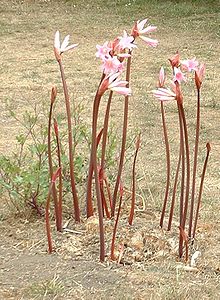Amaryllis belladonna
| Amaryllis belladonna | |
|---|---|

| |
| Scientific classification | |
| Kingdom: | Plantae |
| Clade: | Tracheophytes |
| Clade: | Angiosperms |
| Clade: | Monocots |
| Order: | Asparagales |
| Family: | Amaryllidaceae |
| Subfamily: | Amaryllidoideae |
| Genus: | Amaryllis |
| Species: | A. belladonna
|
| Binomial name | |
| Amaryllis belladonna | |
| Synonyms[1] | |
|
Species synonymy
| |
Amaryllis belladonna,[2] the Jersey lily,[3] belladonna-lily, naked-lady-lily,[4] or March lily,[5] is a plant species native to Cape Province in South Africa but widely cultivated as an ornamental. It is reportedly naturalized in many places: Corsica, Portugal, the Azores, Madeira, the Canary Islands, the Scilly Isles of Great Britain, the Democratic Republic of the Congo, Ascension Island, Australia, New Zealand, Mexico, Cuba, Haiti, the Dominican Republic, Chile, California, Texas, Louisiana, Mississippi, Michigan and the Juan Fernández Islands.[6][7]
Description[edit]
Perennial bulbous geophyte with one to two erect solid stems which appear in late summer. The inflorescence bears 2–12 showy fragrant funnel-shaped flowers on a 'naked' (leafless) stem, which gives it the common name of naked-lady-lily. The pink flowers which may be up to 10cm in length, appear in the autumn before the leaves (hysteranthy) which are narrow and strap shaped.[4][5]
Taxonomy and etymology[edit]
Amaryllis belladonna is one of the two species in the genus Amaryllis as currently circumscribed.[8]
The specific epithet belladonna is derived from the Italian bella donna, which means beautiful lady.[9]
Habitat[edit]

Amaryllis belladonna is found in South Africa, where the plants are found growing among rocks.[5]
Ecology[edit]
Leaves of A. belladonna begin growing in early spring, or during late autumn. They last for a few weeks to a few months until they wither away, and a flower stalk will begin growing. When found in the wild, Amaryllis belladonna is pollinated by hawk moths and carpenter bees. The flower has a long-tubed, pale perianth, which fully expands at night. This flower will then release a sweet fragrance, that contains acyclic terpenoid alcohol, linalool and abundant nectar, that attracts pollinators to it.[10] A. belladonna seeds are soft and fleshy, and appear white or pinkish. They are dispersed through wind dispersal during the winter time. This is to coincide with the first winter rain during March, and April. Seeds will germinate in as early as two weeks, but will not develop into a fully flowering plant until three to six years later.[citation needed]
All parts of the A. belladonna plant are toxic and contain several different alkaloids, such as lycorine, pancracine and amaryllidine. This can cause vomiting and diarrhea in humans. In wildlife these toxins will affect grazing species, and will cause drooling, vomiting, diarrhea, abdominal distress, lethargy, and heart or renal failure. Deer will avoid eating this plant, possibly due to an evolutionary relationship.[11]
Cultivation[edit]
The bulbs are best planted just below the surface of the soil, with the neck of the bulb level with the surface. In colder climates mulching or lifting and overwintering is required. The bulbs may be propagated from offsets. Amaryllis bulbs require little watering and are drought tolerant.[5] This plant has gained the Royal Horticultural Society's Award of Garden Merit.[4]
Medicinal properties[edit]
Several compounds have been found in A. belladonna bulbs, including, 1,4-dihydroxy-3-methoxy powellan, which is an alkaloid. It has been observed that alkaloids in this plants bulb have properties to fight against malaria caused by P. falciparum.[12]
See also[edit]
References[edit]
- ^ Amaryllis belladonna, The Plant List
- ^ Linnaeus, Carl (1753). Species Plantarum. Vol. 1. p. 293 – via Biodiversity Heritage Library.
- ^ BSBI List 2007 (xls). Botanical Society of Britain and Ireland. Archived from the original (xls) on 26 June 2015. Retrieved 17 October 2014.
- ^ a b c RHS 2015.
- ^ a b c d Phipps 2011.
- ^ "Amaryllis belladonna". Kew World Checklist of Selected Plant Families.
- ^ "Amaryllis Belladona distribution map". Biota of North America Project.
- ^ "Search for Amaryllis". World Checklist of Selected Plant Families. Royal Botanic Gardens, Kew. Retrieved 1 February 2015.
- ^ Gledhill, David (2008). The Names of Plants (4th ed.). Cambridge University Press. p. 68. ISBN 978-0-521-86645-3.
- ^ Manning, J. C.; Snijman, D. (1 July 2002). "Hawkmoth-pollination in Crinum variabile (Amaryllidaceae) and the biogeography of sphingophily in southern African Amaryllidaceae". South African Journal of Botany. 68 (2): 212–216. doi:10.1016/S0254-6299(15)30422-1.
- ^ "Is Amaryllis Belladonna Toxic?". Garden Guides. Retrieved 19 February 2021.
- ^ Cho, Namki; Du, Yongle; Valenciano, Ana Lisa; Fernández-Murga, Maria L.; Goetz, Michael; Clement, Jason; Cassera, Maria B.; Kingston, David G. I. (1 January 2018). "Antiplasmodial alkaloids from bulbs of Amaryllis belladonna Steud". Bioorganic & Medicinal Chemistry Letters. 28 (1): 40–42. doi:10.1016/j.bmcl.2017.11.021. PMC 5753767. PMID 29162457.
Bibliography[edit]
- RHS (2015). "Amaryllis belladonna: belladonna lily". Retrieved 1 April 2015.
- Dressler, S.; Schmidt, M. & Zizka, G. (2014). "Amaryllis belladonna". African plants – a Photo Guide. Frankfurt/Main: Forschungsinstitut Senckenberg.
- Carter, Kathie. "Amaryllis. Amaryllis belladonna (Brunsvigia rosea) and Hippeastrum hybrids" (PDF). Center for Landscape and Urban Horticulture. Cooperative Extension/Botany Plant Sciences Dept. University California Riverside. Retrieved 24 January 2015.
- Phipps, Nikki (9 February 2011). "Amaryllis Belladonna Planting – How To Grow Amaryllis Bulbs". Planting Flower Bulbs. Archived from the original on 24 January 2015. Retrieved 1 April 2015.
- Adams, T. (2001). "Amaryllis belladonna L." PlantZAfrica.com. South African National Biodiversity Institute. Retrieved 2 April 2015.
![]() Media related to Amaryllis belladonna at Wikimedia Commons
Media related to Amaryllis belladonna at Wikimedia Commons
